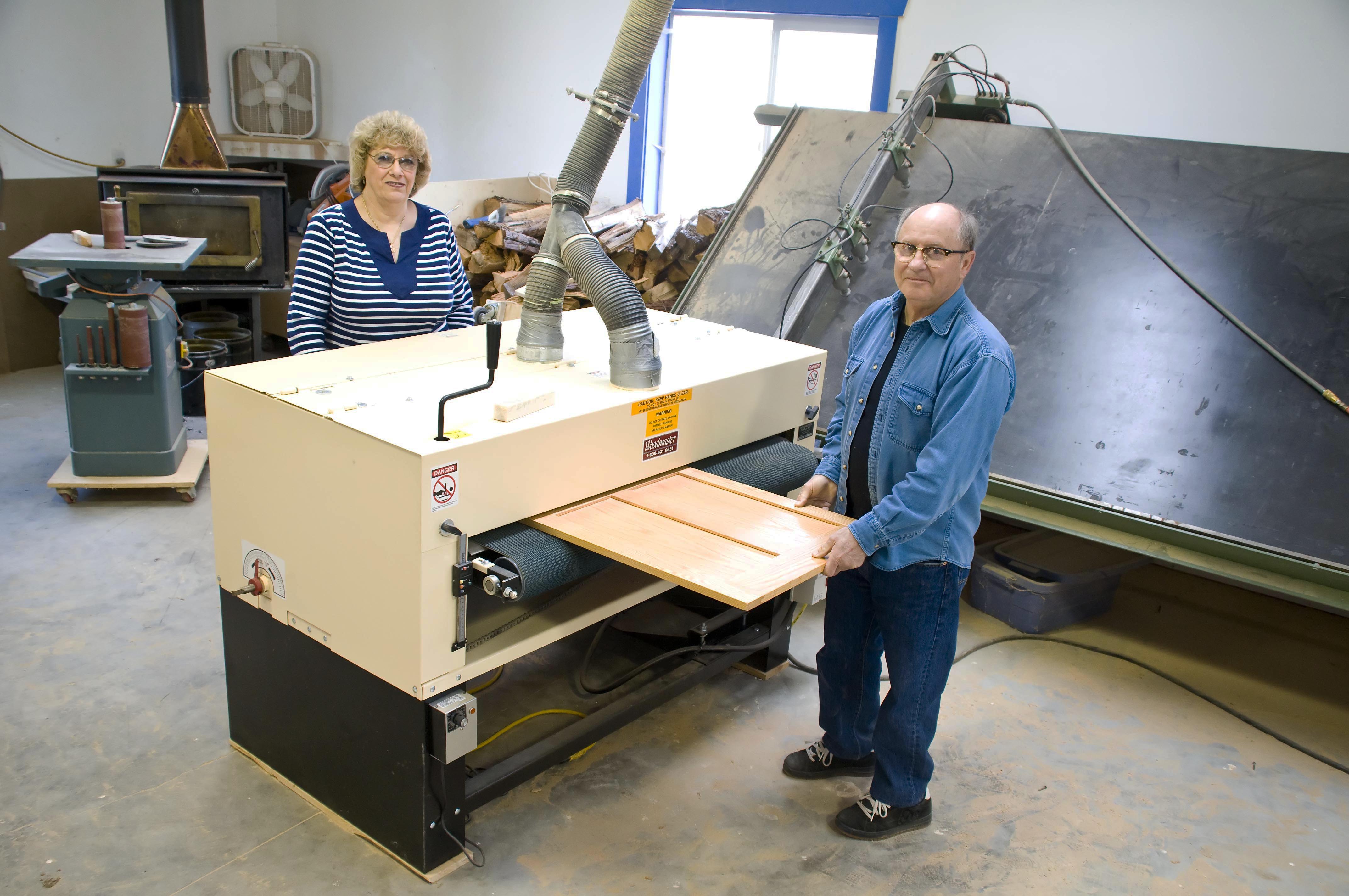Struggling to achieve the desired finish on your woodworking project? You don’t have to anymore!
Using a drum sander can give you professional-grade results quickly and conveniently. This guide will explain the features and benefits of drum sanders and how they can improve your woodworking projects.
Drum sanders are among the most essential woodworking power tools in any woodworker’s arsenal. They can be used to quickly reduce huge amounts of excess material from the stock and prepare them for further refinements.
Drum sanders offer many advantages over other methods of finishing wood and are particularly beneficial when working large batches of material or objects that require intricate, yet precise results. While some knowledge of how drum sanders work is helpful for optimal performance, purchasing one for a personal workshop or professional use is often a simple process that requires minimal fuss.
This guide will examine the advantages, differences between types of drum sanders, and how to select the best one for your needs as you consider using this powerful tool.
Advantages of using a drum sander
Drum sanders offer a number of advantages for woodworking projects, making them a desirable tool for the job. The most notable advantages include:
- Time-Saving: By quickly removing excess material and creating smooth, even surfaces, drum sanders help you save time on your projects. They maximize efficiency by quickly completing the steps that would otherwise take much longer to do by hand.
- Ease of Use: Drum sanders are an uncomplicated tool to use, as long as all safety protocols are followed. Precise, simple adjustments can be made to customize the sanding process to best suit your needs and desired results.
- Efficiency: Drum sanders are designed with efficiency in mind; they produce consistent results far superior to any manual process and in less time than with traditional techniques such as sanding blocks or portable card scrapers. A drum sander helps you finish projects quickly with a professional level of quality that would otherwise take much longer and more effort than is necessary with hand operated tools.
- Cost Savings in Material: By using the right grade of abrasive paper compared to doing finishing work by hand, you will experience cost savings due to less loss of material during the process and improved productivity throughout the entire project lifecycle. Similarly just like hardwood floors – drum sanders can be used in order to beautify preexisting or new floors similarly reducing costs due to minimal product wastage and floor grinding work which is both intensive but effective depending on your outcome goals in beautifying your floors!
Smoother finish compared to other sanders
Using a drum sander for woodworking can give you much smoother results than other types of sanders. Unlike with random orbital sanders or belt sanders, which may create swirls that appear after the surface is finished, a drum sander produces results that are almost perfectly even.
The rotating drums on these units reduce the potential for any scrapes and divots on the material you are sanding, resulting in a smooth finish without any grooves. Additionally, because the drum is consistently moving over the wood at an even pace, it creates less dust and creates much cleaner edges along walls and other straight lines.
Since a drum sander rotates more slowly than most other types of sanders, it also allows you to complete larger surfaces quicker while still creating precise results.
Greater control and precision
Drum sanders bring greater precision and control to woodworking projects than is possible with hand sanding. The cylinder shape of the sander helps make sure that surfaces are flat and even, with no dips or gouges, while the spinning drum allows you to reach into intricate details without needing to worry about gouging them. This makes it much easier to get a pristine finish on small pieces of furniture, difficult angles, doors and other complex shapes.
By reducing the risk of errors, drum sanders make it easier to cut down on both wasted wood and wasted efforts.
Time-saving compared to other sanding methods
The drum sander is an efficient tool that can save the woodworker substantially more time than traditional sanding tools. Due to its ability to work on a large area at once, projects involving sanding large flat surfaces can be completed much quicker using a drum sander than by hand sanding. Furthermore, the effectiveness of the machine means that it is much more thorough than manual methods – allowing you to achieve a smoother finish in less time.
Unlike most stationary sanders that use abrasive pads or interchangeable discs, a drum sander features cylindrical drums wrapped in abrasive paper so that when running, wears away the material gently over its surface. The drums are designed for durability and can keep their shape even with rigorous use; keeping your project looking professional and maintaining consistent results with each task.
Drum Sanders are an extremely flexible tool and come in either stationary or portable formats – depending on your individual needs. This flexibility makes them ideal for larger scale production facilities where speed is essential – as well as being well-suited for smaller projects like finishing finer pieces of furniture. Not only does this make them applicable to a wide range of tasks – but also allows them to fulfill many stages within any project quite easily.
Due to their versatility, dependability and speed, Drum Sanders—particularly vertical machines—are fast becoming one of the most popular woodworking tools around by both professionals and hobbyists alike; offering unmatched convenience without compromising results!
Can handle large and thick pieces of wood
Using a Drum Sander for woodworking projects has many advantages in terms of time and effort. It can handle large and thick pieces of wood quickly, making it possible to finish projects faster. This saves time, which is especially beneficial for professionals who are dealing with tight deadlines or large jobs. Moreover, a drum sander can make intricate details on larger pieces that would be difficult by hand. It also provides uniform results in terms of the surfaces being smooth and even, giving a professional-grade finish. Additionally, its powerful motor prevents sandpaper from clogging or becoming worn away prematurely when working with thicker woods.
In general, any job that requires smoothing down large surfaces is perfect for a drum sander as it will do the job faster and more efficiently than smaller hand-held models or manual sanding techniques. As discussed previously, this type of sander is best suited to woodworking projects that involve larger pieces since these require more considerable effort when working on them by hand. The drum sander’s ability to manage big jobs quickly makes it ideal for professional woodworkers dealing with tight deadlines who require superior results in minimal timeframes while achieving precise details on their creation.

Less dust produced during sanding
Using a drum sander eliminates much of the dust produced during woodworking sanding. The wood pieces are loaded into the machine, and a vacuum is used to suck dust away from the blade as it sands. This helps keep dust out of the air, which can be both healthier for you as a user and reduce any damage to surfaces in the vicinity.
Drum sanders also produce even results that make it less likely that additional sanding will be required, saving time and energy.
Can be used for both rough and finish sanding
A drum sander is an essential tool for woodworking. This power sanding tool can be used for both rough and finish sanding on a variety of woodworking projects. The rotating drum of the sander is covered in sandpaper, allowing it to abrade the surfaces of workpieces at a much higher speed than manual sanding. With its ability to remove stubborn chips and planar inconsistencies, a drum sander is an invaluable tool for any workshop.
To use a drum sander, the operator must first insert some replacement abrasive paper into the machine’s drum. Depending on the size and model of your machine, you may need to affix two or more pieces together using clamps or aluminum-oxide tapes as most machines can only accommodate limited lengths of paper. Once in place, start up your sander and feed your workpiece through it either manually or by pushing down with appropriate pressure if your machine has adjustable speeds and depth control capabilities.
For coarse sanding applications such as removing large flaws and smoothening rough-cut edges on timber, utilize grits that range from 36 to 120 grits. In contrast, around 150-grits with finer variations such as 220-grits are better suited for light duty finishing applications while tougher materials may require all the way up to 400-grit paper if you’re looking for a smooth surface free from visible scratches.
Maintenance and care of drum sanders
In order to maximize the life of your drum sander, there are a number of actions that should be taken to ensure proper maintenance and care. These include:
– Cleaning the Machine Regularly: To keep rust and corrosion from occurring, it is important to ensure that you are regularly cleaning the machine down. You should always inspect the surfaces of your sander after each use to ensure it is free of dirt and debris which can be abrasive over time.
– Lubrication: For optimal performance, it is important that almost all moving parts are lubricated. This includes any chains, spindles, axles or wheels which can easily seize up if left without lubrication for an extended period of time. When oiling your sander, be sure to avoid using oil based products as these can often cause damage. Instead use a non-drying lubricant such as grease or wax.
– Inspections: Regular inspections should be conducted in order to detect any signs of wear and tear or potential issues with your machine’s components. All safety guards need to properly cleaned and inspected for damage on a regular basis as well as all parts being checked for any signs of wear or defects before use.
– Replacing Parts: Be sure that you have the correct spare parts in case certain elements break down such as sanding drums or drive belts etc. Having these on hand will allow you to quickly replace any necessary components and not have long downtimes due to lack of adequate resources available when needed.
Cleaning and maintenance tips
Cleaning and maintaining your drum sander is essential to keep it in top working condition and ensure that it produces consistent results each time. Prior to use, check the drum for any nicks or ridges that can result in bumps or voids in wood projects. Remove these with a light sanding with a fine grit paper.
Use a soft brush to dust off the exterior of the sander after use, as well as on and around the interior components of the unit. Clean the abrasive drum with either a wire brush or scrap wood block when necessary.
Make sure that all movable parts are functioning properly by regularly lubricating all gearing, bearings, and drive systems with non-detergent 3-in-1 oil. Faulty brakes, particularly those for belt pressure drums should be fixed immediately to avoid potential hazards. Also check for worn belts and any clogging from sawdust buildup near openings along seals or belts of your machine, since this could impede functionality of your sander’s motor or cause overheating during operation.
Common problems and solutions
Drum sanders are powerful tools for woodworking and can help smooth out uneven surfaces and level out corners, but they do have their own set of issues and potential problems to consider. The most common problem with using a drum sander is sanding too deep, or potentially damaging the wood if the depth setting isn’t correct. To avoid this issue, keep in mind that a good rule of thumb is to only use the lightest pressure possible – generally speaking, you should never go deeper than half the board thickness.
In addition to pressure control, dust collection is another important aspect of operating a drum sander, as with any type of power tool. Be sure to keep your work area free of debris so you can ensure that all dust is being sucked into the power tool’s dust collection bag. It’s also important to check your machine regularly for worn parts and replace it if necessary.
It’s also essential that your workpiece be properly clamped down before beginning any sort of sanding operation – improper clamping can lead not only to an uneven surface finish or potential damage to the wood but can even be dangerous in some cases. Additionally, make sure you double-check for any nails or screws in the wood before operating – these could become projectiles during sanding operations if not caught beforehand! Following these steps will help ensure that you get great results from your drum sander!
Long-term care and storage
When using a drum sander for woodworking, it’s important to consider long-term care and storage of your tool and materials. Without proper care, a drum sander can become less effective and create uneven or even damaged results.
To ensure your drum sander lasts for years of successful projects, consider these tips for long-term upkeep:
– Keep the machine clean by vacuuming out dust particles and running a damp cloth over the surface. Doing this every few months can prevent clogs and malfunctions.
– Keep all hardware, including nuts and bolts, tight so they don’t wiggle loose during use.
– Remove stock completely before storing to avoid jams in the rollers when you start up next time.
– Store in a dry area away from moisture so rusting doesn’t occur on any of the vital components including its motor or sanding drums. It’s also important to store away from direct sunlight which could damage its exterior over time.
– Inspect regularly for chips in the cutting teeth or it will reduce overall performance as well as create defects in your workpieces which causes uneven surfaces on your work pieces. Replace these when needed to avoid frustration moving forward with future projects.
Conclusion
In conclusion, a drum sander is an essential tool in any woodworker’s arsenal. It can save time and money by quickly and accurately sanding all varieties of woodworking projects. The drum sander has numerous features that make it ideal for any job, such as adjustable speed levels, variable power settings, and variable height settings.
Additionally, a drum sander’s powerful motor and excellent dust collection system make it an ideal choice for controlling dust and making your workspace safer than ever before. A drum sander is an invaluable tool for all types of woodworking jobs from small home repair projects to large-scale furniture construction tasks.
With the right care and regular maintenance, your drum sander will continue to provide quality workmanship for years to come.
FAQ’S
What are common uses for a drum sander?
Common uses for a drum sander include sanding large surfaces, removing old finishes or paint, and leveling or flattening uneven or rough surfaces.
What is a drum type sander?
A drum type sander is a power tool that uses a rotating drum covered with sandpaper to sand and smooth wood surfaces.
What does a sander do to wood?
A sander removes material from wood surfaces by abrasion, leaving a smoother and more even finish.
Will a drum sander flatten wood?
Yes, a drum sander can flatten wood by removing uneven or rough surfaces, resulting in a smooth and level surface.
What is the advantage of a drum sander over a planer?
The advantage of a drum sander over a planer is that it can sand a wider range of materials, including finished surfaces, and can be more precise in removing small amounts of material.
What is the most useful sander?
The most useful sander depends on the task at hand, but an orbital sander is often considered the most versatile and useful for a variety of sanding tasks.
Can a beginner use a drum sander?
Yes, a beginner can use a drum sander with proper instruction, safety precautions, and practice.
Is drum sander better than orbital sander?
A drum sander and an orbital sander serve different purposes and are not necessarily better or worse than each other. A drum sander is better for sanding large surfaces and removing significant amounts of material, while an orbital sander is better for finishing and smoothing smaller surfaces.
How fast does a drum sander work?
The speed of a drum sander varies depending on the model and settings, but most drum sanders operate at a speed of 1,700 to 2,200 RPM.
What grit is best for drum sander?
The best grit for a drum sander depends on the task at hand, but for initial rough sanding, a coarse grit such as 60 or 80 is appropriate, while for finishing, a fine grit such as 220 is best.
See more:
- Best oscillating sander
- Best palm sander
- Best random orbital sander
- Best sander
- Best sander for deck


